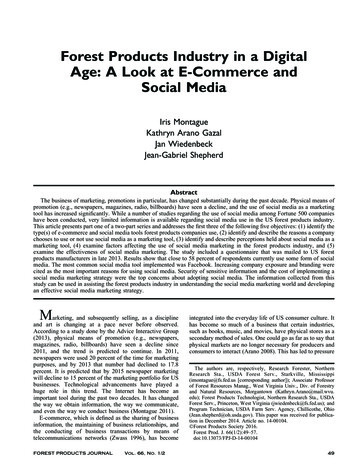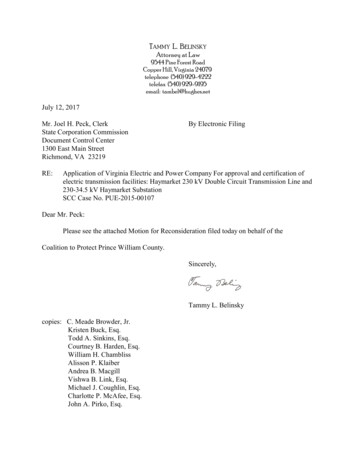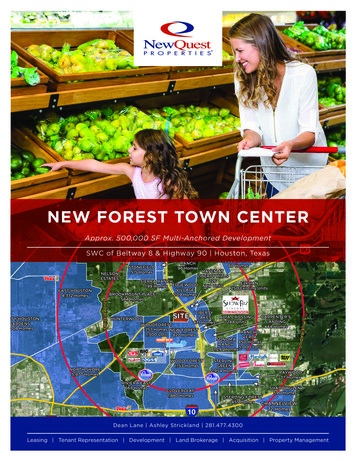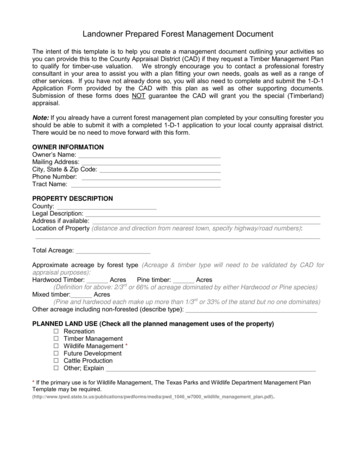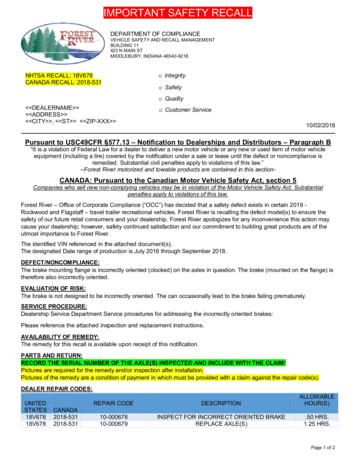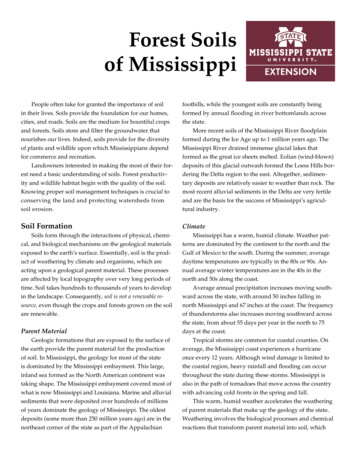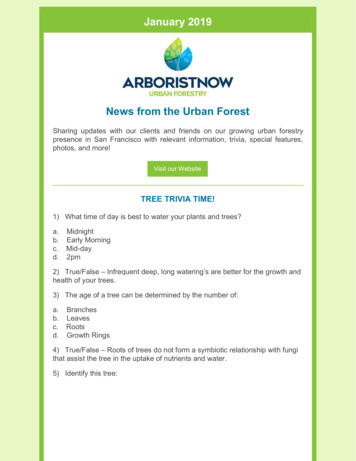
Transcription
January 2019News from the Urban ForestSharing updates with our clients and friends on our growing urban forestrypresence in San Francisco with relevant information, trivia, special features,photos, and more!Visit our WebsiteTREE TRIVIA TIME!1) What time of day is best to water your plants and trees?a.b.c.d.MidnightEarly MorningMid-day2pm2) True/False – Infrequent deep, long watering’s are better for the growth andhealth of your trees.3) The age of a tree can be determined by the number of:a.b.c.d.BranchesLeavesRootsGrowth Rings4) True/False – Roots of trees do not form a symbiotic relationship with fungithat assist the tree in the uptake of nutrients and water.5) Identify this tree:
Hint: It is one of San Francisco's Landmark trees.The first 3 people to email the correct answers to each of these questionswins! The first person will win a Victorinox Swiss Army Knife and a 200voucher. The next 2 people will win a 100 voucher for any tree service.*Past FIRST place winners may play for fun; however, only one FIRST placewin per person in a 12 month period.Please email email your answers to news@arboristnow.com with "QuizAnswers" in the subject line.Good luck!Congratulations to our December Newsletter winners!Catherine W.Doug E.December Answers:D. Germany B. 6-10 years True B. Parasite D. Washington PineFROM OUR BLOGInvasive Trees to Avoid on Your PropertyIf you live near a heavily wooded area, or have additional trees in yourlandscaping that you did not plant yourself, you may want to be on the lookoutfor invasive tree species on your property.We are going to be discussing what makes a species of trees invasive, as wellas the most common invasive trees in the United States to watch out for.What Makes a Tree Species Invasive?
Read moreJOKE OF THE MONTHDid you know that I can cut down a deadtree just by looking at it?It’s true. I saw it with my own eyes!EMPLOYEE HIGHLIGHTMEET CATALINAPERALTAField Coordinator Catalina grew up in Santiago,Chile and moved to Canton,Ohio when she was 12 yearsold. In Ohio, she attended KentState University where shegraduated with a degree in Biology in 2012. After graduating, Catalina movedto Texas to work at an animal rescue and sanctuary called Wildlife Rescue andRehabilitation (WRR). At WRR she cared for a wide range of animals fromnative wildlife, in the rehabilitation hospital, to exotic animals, such as Lemursand African Lions, living in multiple acre enclosures on the 384-acre property.In 2016, Catalina left WRR to fulfill her passion for travel. With her fiancé andtheir dog Stella, Catalina circumnavigated the country living in their truck fornine months; exploring some of the most beautiful places in the United States.When money started running low, they moved to the Bay Area to find work.Using her animal care experience to get a job as a ranch hand caring forhorses, the work was less than satisfying for Catalina; so she set out in search
of something opposite of her animal care jobs. She shifted her focus to a job inplant care and found Arborist Now. Catalina has always had a passion for photography and all things flora fromgardening, to the way it feels walking through an old growth forest. Her love oflearning and urban forestry, provides a great venue for her continued growthand the expression of her artistic eye at the same time.Catalina is an excellent addition to the growing team of Arborist Now!LANDMARK TREES OF SAN FRANCISCOPhoenix canariensisA.K.A Canary Island Date PalmLocation: Dolores St. Center IslandPhoenix canariensis is native to the Canary Islands, a Spanish archipelago offthe coast of Northwestern Africa. It is a large dioecious solitary palm that cangrow up to 66 feet tall. The fronds are composed of pinnate leaves that can beup to 10 feet long with 80-100 leaflets on each side of the central rachis. P.canariensis has beautiful clusters of orange flowers that grow in late springand, when pollenated, produce edible fruit that contain one large seed. Despitebeing a subtropical species, these palms are extremely hardy in cold weatheras long as the summers are hot. They do grow best in well-drained soil and fullsun. These palms grow fairly slowly but need ample space to thrive.The first known documented introduction of Phoenix canariensis to theAmerica’s has been credited to California nurserymen. The nursery of Millerand Sievers in San Francisco was the first one to offer it for sale in 1874. Therise of its ornamental popularity was launched by John Rock (1836-1904) whoestablished a nursery near San Jose called California Nursery Company whichoffered P. canariensis in their 1884 catalogue. Today, P. canariensis is one ofthe most popular ornamental trees distributed around the world.The most interesting aspects of the natural history of P. canariensis are thetraditional uses of the palm that Canary Island inhabitants have developed.They have learned to respect the palm and use every part of the plant in theirdaily lives. The fronds have historically been used as rich food and supplementfor raising cattle. In addition, the fronds and other parts can be stripped andturned into cordage to make different kinds of household items such as hats,brooms and screens. The sap of the tree, called “guarapo” by natives, is themost valued resource of P. canariensis. It is extracted using a very oldtechnique that guarantees the survival of the palm for future generations. Thesap is not collected from the trunk of the tree, as sap is collected from maplesfor syrup production, contrarily it is extracted from the very tip or apicalmeristem. It can be used to make a myriad of things from honey and wine tovinegar. Unfortunately, many of these traditions and techniques are no longerbeing practiced due to advancements in technology. But, don’t let that stop youfrom planting your own P. canariensis and learning more about the oldtraditions, or forming some new ones, around this beautiful palm.
THE BIG REVEAL!A new year and a new look for Arborist Now!Here it is . our new logo!Let us know what you think!FROM THE FIELDOur crew in action!
We Appreciate YOUR Feedback!Tell us how we're doing!Thank you for choosing us Arborist Now for your tree care and landscapeneeds! We would love to know your thoughts about your experience with us sowe can provide you with the best service possible!Please leave us a review on the links below! We're very grateful to you and foryour feedback!YelpGoogle ReviewsReceive a beautifully craftedVictorinox Swiss Army Knifewith any service booked byFebruary 14, 2019!This offer must be mentionedat the time of booking yourappointment for service!Call today!ServicesArborist Now, Inc. 415-310-7781 news@arboristnow.com arboristnow.comSTAY CONNECTED
and the expression of her artistic eye at the same time. Catalina is an excellent addition to the growing team of Arborist Now! LANDMARK TREES OF SAN FRANCISCO Phoenix canariensis A.K.A Canary Island Date Palm Location: Dolores St. Center Island Phoenix canariensis i




